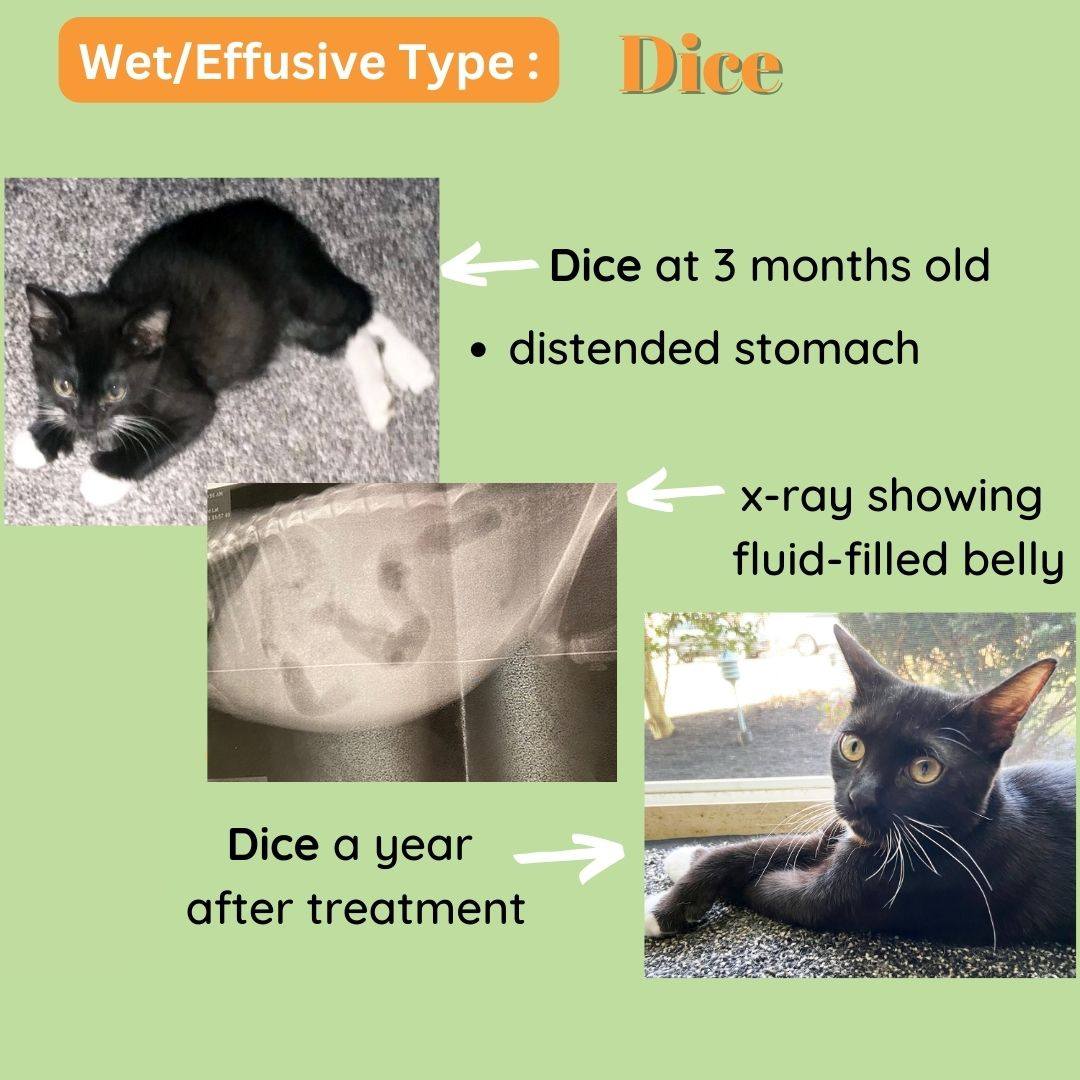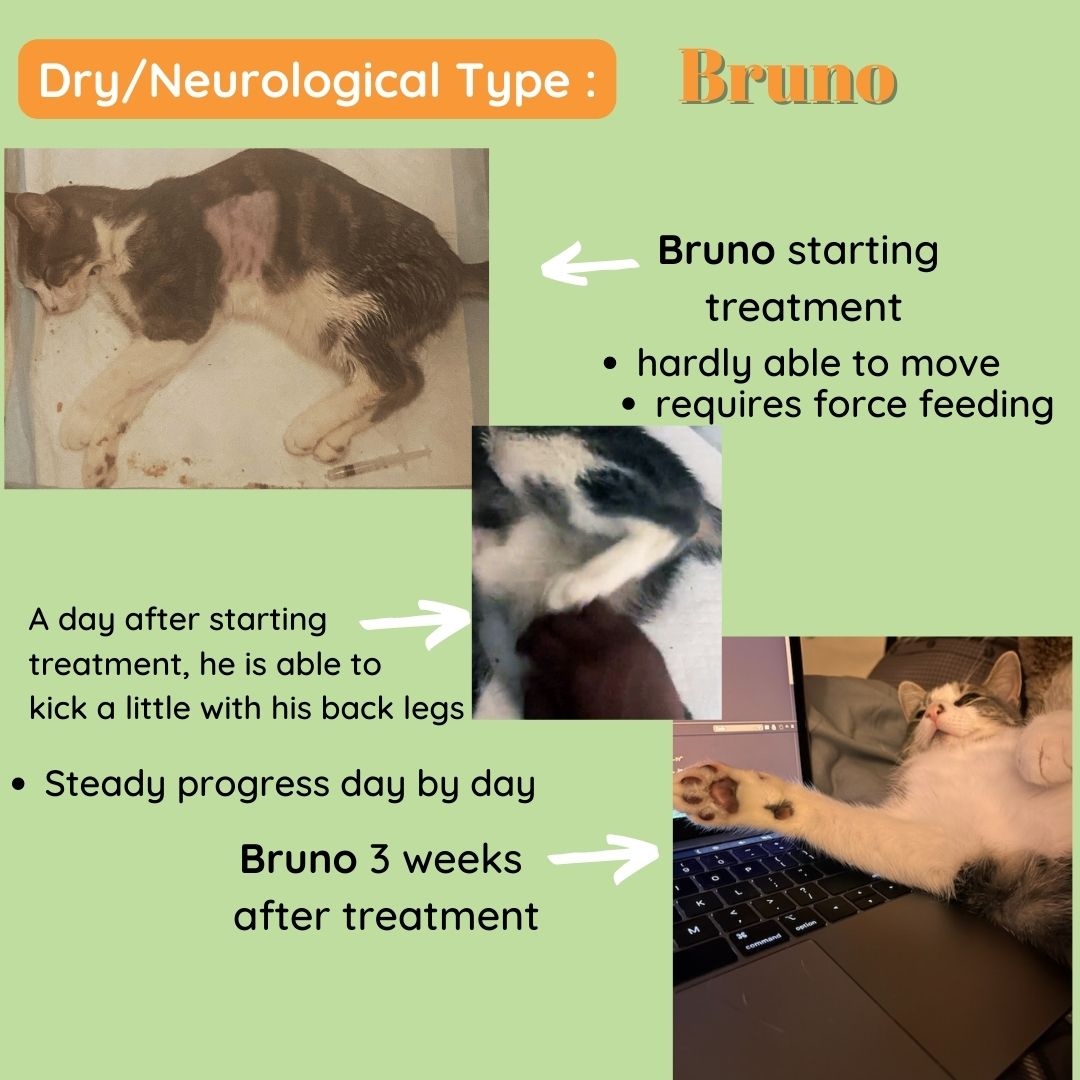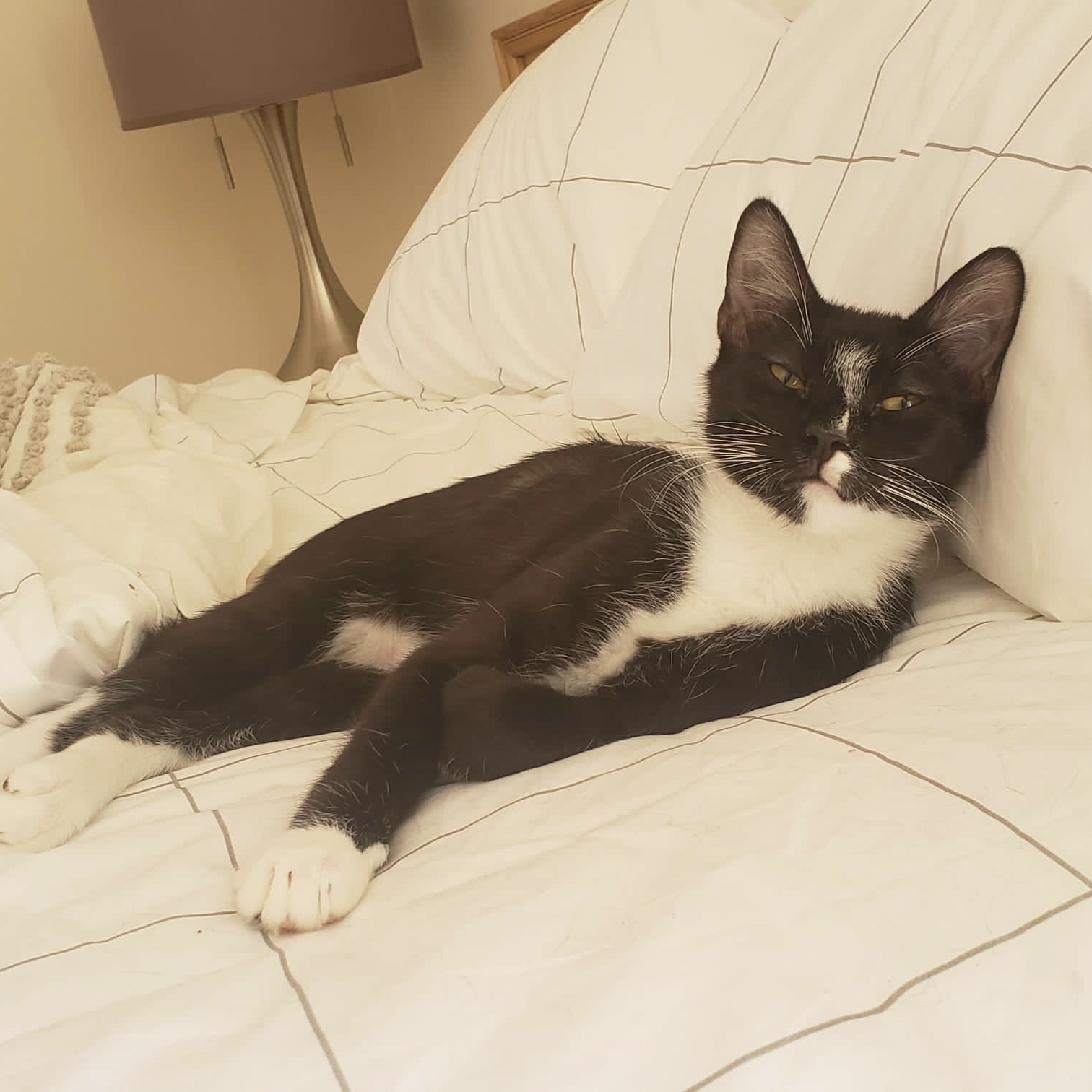What is FIP?
FIP stands for feline infectious peritonitis. The disease occurs when a very common (and typically harmless) virus called feline enteric coronavirus (FCoV) mutates within a cat’s body. This occurs most often in cats with more delicate or undeveloped immune systems which is why this disease is most commonly seen in kittens. A cat does not have to be suffering from an active FCoV infection to have it mutate into FIP. If a cat has had FCoV at some point in their past, even if they are fully recovered from it, they have a possibility of contracting FIP.
Not much is currently known about the exact triggers for this mutation, and it’s currently unknown as to why certain cats are susceptible to it, but two known triggers are trauma and stress. Symptoms often occur a few months after a period of extreme stress such as a rehoming or a traumatic event such as spay or neuter. While
the coronavirus that causes FIP is contagious, FIP itself is not. Cats cannot pass FIP to each other.
If left untreated, FIP is 100% fatal. However, effective and safe treatment has been developed after successful clinical trials at UC Davis. Unfortunately, the treatment has not yet been approved for use by veterinarians (see “the vet’s dilemma” for details). Not all veterinarians have an understanding of the disease or treatment. As such, many still consider it to be a death sentence and will recommend euthanization. As a result, cat guardians must take it upon themselves to advocate for their cats and begin treatment on their own. Some vets will partner with you throughout the process, but this is dependent on the individual vet.
Diagnosing FIP
Diagnosing FIP is challenging because it is what is known as a disease of exclusion. There is no definitive laboratory test that can accurately diagnose FIP, so the only way to diagnose it is to exclude all the other possibilities, and early symptoms can mirror other illnesses, both life-threatening and non-life-threatening. We must rely on markers in blood work or an examination of fluid or tissue, as well as observation of telltale signs such as fluid buildup/distended belly or neurological issues such as seizures or difficulty walking.
Time is of the essence when treating FIP. Rather than putting your kitten through painful, traumatic and expensive tests and scans, and wasting precious time waiting for results to exclude other illnesses, it is recommended to immediately start treatment if FIP is suspected. There is no harm in starting without a confirmed diagnosis, as there are no dangerous side effects or drug interactions. If your cat does have FIP, you will likely notice a marked improvement in symptoms within a day or two, and certainly within the first week.


Treating FIP
FIP treatment requires a daily dose of pills or injections for a minimum of 84 days (pills are not recommended for the first month of treatment due to gastrointestinal absorption issues). Progress is monitored through regular analysis of blood work and doses are adjusted as needed based on severity of symptoms and weight. Depending on the final bloodwork before stopping treatment, an extension of treatment may be necessary to eliminate any lingering FIP markers to minimize the chance of relapse. After the treatment period, cats will enter an observation period for another 84 days in which the cat is monitored for any recurrence of symptoms. After this period, the cat is considered cured. The treatment is costly but effective (more effective than many cancer treatments routinely administered by vets), and the only option to save your cat’s life. There are many vets who will be happy to partner with you throughout the process and you will receive continued support from the Facebook group, FIP Warriors 5.0, as well.
This video of Bruno’s FIP treatment shows how quickly the drugs can start to work. (click link to view the video)
What to look for and what to do *right now* if you suspect your cat has FIP
Join the Facebook group FIP Warriors 5.0 immediately if:
- If your vet has diagnosed FIP OR suspects FIP OR
- If your cat has a fever, lethargy, loss of appetite, and a distended belly and/or
- If your cat has neurological systems such as seizures, difficulty moving limbs, or problems with vision
- and especially If your cat is less than two years old (FIP is most common in young cats)
FIP Warriors 5.0 is dedicated to curing FIP. It is a private group; you will have to request membership and describe your cat’s symptoms. An admin will usually admit you to the group within a few hours and send you a private message with the next steps. You will be assigned a personal admin to oversee your case, and they will provide you with literature and instructions on treating your cat. They will also arrange for you to receive shipments of medication and can even put you in contact with emergency medication providers who will provide you with medication and supplies so you can begin treatment immediately. There is hope for cats who have FIP. Be attentive to symptoms indicative of FIP and seek treatment immediately.
Want to dig deeper? Learn more about FIP here
The Vet’s Dilemma
There is an antiviral drug called GS-441524 that can treat FIP. Its efficacy has been demonstrated in clinical trials at UC Davis. Unfortunately, Gilead Sciences, the company that developed the drug, refuses to license it for veterinary purposes. Therefore, veterinarians cannot prescribe it, and consequently, they have no direct experience with it. Some veterinarians aren’t even aware that it exists. However, Chinese companies have been making GS-441524 for several years. It can be obtained in the United States through various channels, and many people have used it successfully to treat their cats. A study published in Animals in 2021 confirms the effectiveness of at-home treatment with unlicensed GS441524-like drugs.
As the treatment is not approved, even veterinarians who want to treat their FIP positive patients can only tell you that there’s a treatment out there that seems to work. Some veterinarians might say that the treatment is experimental. Others may be hesitant to even mention there is treatment. Certain veterinarians will share the Facebook group FIP Warriors 5.0, a group dedicated to curing cats of FIP. The administrators of the group have more experience treating FIP than veterinarians, and they are an excellent resource for people dealing with a suspected or diagnosed case of FIP.
The Signs of FIP
Common signs of a cat with FIP can include listlessness, lethargy, decreased or absent appetite, weight loss, and a fluctuating fever. After a few days or weeks, other symptoms typically begin to occur.
Most cats will develop the “wet” or effusive form of FIP. This refers to the accumulation of fluid that may gather in the abdomen (leading to a swollen abdomen) or in the chest (leading to difficulty breathing). Wet FIP is easier to diagnose, but it is also more aggressive.
Some cats will develop the “dry” or non-effusive form of FIP where little to no fluid accumulates. Instead, the dry form often involves severe inflammation in one or more organs including the eyes, brain, liver, and intestine.
Unfortunately, dry FIP is more challenging to diagnose. If a cat is doing poorly, has a fever, a distended belly, or neurological symptoms, and its albumin and globulin levels ratio is low, it is very possible that FIP is the cause.
When there are neurological symptoms, veterinarians often refer clients to a neurologist for an MRI or a cerebrospinal fluid tap. However, this is costly, and if the cat has FIP, it might be too late by the time the client gets an appointment with a neurologist and the tests are performed.
The most effective method of determining possible FIP is through examination of a blood work, specifically a full CBC and chem panel. Many veterinarians will suspect FIP if there are certain blood marker groups in the blood work that have abnormal values.
Once the disease develops, most cats deteriorate rapidly, but some can remain normal for several weeks. If you notice any of these symptoms see your veterinarian immediately and begin treatment even without a definitive diagnosis. The sooner you start treatment, the better.
FAQs and Further Reading
FAQs
Is FIP Contagious?
According to the leading FIP researcher, Dr. Niels Pedersen of UC Davis, only a small percentage of cats with the mutation develop FIP. Furthermore, cats do not pass FIP to each other. The mutated version is only present in diseased tissue, and no longer replicates in the gut, so it cannot be passed from cat to cat.
How common is FIP?
According to the American Veterinary Medical Association, FCoV is shed by up to 60% of cats in multi-cat environments. North American and European studies found that the incidence of FIP is 0.3% to 1.3% among cats. Furthermore, FIP can fluctuate in any given cat population, ranging from as low as zero and as high as 10%. Higher-risk for FIP occurs in dense cat populations including multi-cat households, shelters, and catteries. Also, cats that are stressed (such as being re-homed, recently having surgery, and staying in overnight boarding) or have concurrent infections may be more susceptible to developing FIP as their immune systems are weakened. What cats are most suscept
What cats are most susceptible to FIP?
While FIP occurs in all breeds, SOCK FIP reports that in a study of one pure breed, genetic susceptibility may account for 50% or more of the risk of developing FIP. Certain bloodlines are more likely to result in kittens that develop FIP. Additionally, stress and trauma can be a factor.
How does a cat become infected with FCoV?
Most cats become infected with FCoV through oral contact with infected feces. According to SOCK FIP, cats can shed the virus for 4 months up to a year. The virus can only survive for 24-36 hours in a normal environment, but it is believed that cold temperatures may preserve the virus for months. As explained earlier, most FCoV infections are relatively harmless. Cats may be carrying and shedding the virus without ever showing signs of disease. Although kittens are most susceptible, the virus can mutate and potentially cause FIP at any point in a cat’s life. Most importantly, cats cannot spread FIP to each other.
How is FIP diagnosed?
Diagnosing FIP is challenging because no veterinary laboratory test can definitively establish the presence of FIP. To make a positive diagnosis of FIP a histological examination of affected tissue by a pathologist is needed. 5 IDEXX has also developed a test called FIP Virus RealPCR that can help confirm an FIP diagnosis. However, a positive result from the IDEXX test is not a definitive diagnosis of FIP as not all cats with the mutation that creates FIPV will develop FIP. Therefore, the test can help confirm FIP when the disease is suspected based on other indicators.

For Animals Alumni
Rock Star FIP Survivors

Poppy

Bruno

Dice

